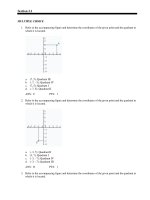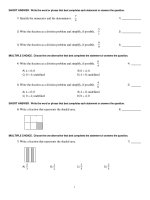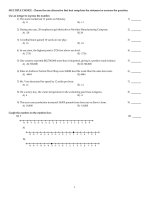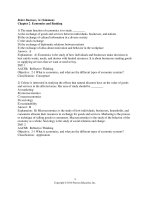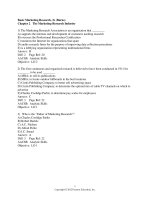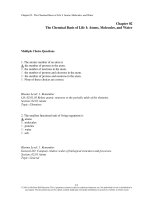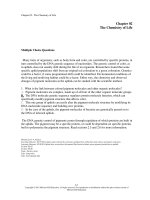Life in the universe 3rd edition bennett test bank
Bạn đang xem bản rút gọn của tài liệu. Xem và tải ngay bản đầy đủ của tài liệu tại đây (49.62 KB, 13 trang )
Test Bank for Life in the Universe, Third Edition
Chapter 2: The Science of Life in the Universe
Chapter 2: The Science of Life in the Universe
1. The possibility of extraterrestrial life was first considered
A) after the invention of the telescope
B) only during the past few decades
C) many thousands of years ago during ancient times
D) at the turn of the 20th century
2. The methods of modern science were originated by the
A) Mayans
B) Egyptians
C) Greeks
D) Babylonians
3. The origins of early Greek science can be traced to the work of the philosopher
A) Aristotle
B) Plato
C) Thales
D) Aristarchus
4. The astronomical object in our sky which plays the most fundamental role in our lives is
the
A) Sun
B) Moon
C) nearest star
D) most massive planet in our solar system, Jupiter
5. In science, conceptual representations of observed phenomena are referred to as
A) facts
B) hypotheses
C) models
D) beliefs
Page 1
Copyright © 2012 Pearson Education, Inc
Test Bank for Life in the Universe, Third Edition
Chapter 2: The Science of Life in the Universe
6. The circular shape of the Earth's shadow on the Moon during a lunar eclipse suggested
to the Greeks that the Earth was
A) cylindrical in shape
B) at the center of the Universe
C) flat
D) spherical in shape
7. The geocentric model of the Greeks consisted of a
A) flat Earth at the center of the universe surrounded by a dome-shaped sky
B) flat Earth at the center of the universe surrounded by a celestial sphere
C) spherical Earth at the center of the universe surrounded by a dome-shaped sky
D) spherical Earth at the center of the universe surrounded by a celestial sphere
8. Apparent retrograde motion occurs when a planet appears to
A) be stationary with respect to background stars
B) move eastward with respect to background stars
C) move due north with respect to background stars
D) move westward with respect to background stars
9. The Ptolemaic model has planets moving in
A) elliptical orbits about the Sun
B) a simple circle about the Earth
C) a simple circle about the Sun
D) small circles, the centers of which move in a larger circle about the Earth
10. The first person to suggest that the Earth moved around the Sun was
A) Aristarchus
B) Newton
C) Copernicus
D) Galileo
11. In the heliocentric (Sun-centered) model, apparent retrograde motion is due to
A) relative motion between the Earth and another planet in its orbit
B) the Earth reversing the direction of its orbit about the Sun
C) a planet moving in a small circle, the center of which moves in a larger circle about
the Earth
D) a planet reversing the direction of its orbit about the Sun
Page 2
Copyright © 2012 Pearson Education, Inc
Test Bank for Life in the Universe, Third Edition
Chapter 2: The Science of Life in the Universe
12. Stellar parallax is the apparent
A) shift in position of nearby stars as the Earth moves around the Sun
B) westward motion of a planet with respect to the background stars
C) shift in position of nearby stars as the Sun moves about the center of the galaxy
D) shift in position of nearby stars as the Earth rotates on its axis
13. Which Greek school of thought believed that both the heavens and the Earth were made
of an infinite number of indivisible units made of the elements fire, water, earth, and
air?
A) the Aristotelians
B) the xenophanes
C) the atomists
D) the milesians
14. Which Greek school of thought believed that the Earth was made of the elements fire,
water, earth, and air while the heavens were made of a fifth element called the aether or
quintessance?
A) the Aristotelians
B) the xenophanes
C) the atomists
D) the milesians
15. Which Greek school of thought naturally lead to the possibility of the existence
extraterrestrial life?
A) the Aristotelians
B) the xenophanes
C) the atomists
D) the milesians
16. Which Greek school of thought rejected the possibility of the existence extraterrestrial
life and insisted that the world must be unique?
A) the Aristotelians
B) the xenophanes
C) the atomists
D) the milesians
Page 3
Copyright © 2012 Pearson Education, Inc
Test Bank for Life in the Universe, Third Edition
Chapter 2: The Science of Life in the Universe
17. Copernicus
A) provided strong observational evidence that the Earth moved about the Sun
B) proved that the orbital shapes of the planets were ellipses and not circles
C) was the first person to suggest the Earth moved around the Sun
D) revived Aristarchus's suggestion of a Sun-centered solar system and described it
mathematically
18. Even though the heliocentric model of Copernicus had many advantages over the
Ptolemaic model, it suffered from the assumption that the
A) planets moved in ellipses about the Sun
B) planets moved in perfect circles about the Sun
C) planets moved in perfect circles about the Earth
D) Earth was not rotating on its axis
19. Tycho Brahe
A) developed a theory of gravity to explain the motions of the planets
B) obtained the first observational evidence suggesting the Earth moved about the Sun
C) showed that the orbits of the planets were ellipses and not circles
D) made detailed measurements of the motions of the planets in the sky
20. Johannes Kepler
A) developed a theory of gravity to explain the motions of the planets
B) obtained the first observational evidence suggesting the Earth moved about the Sun
C) made detailed measurements of the motions of the planets in the sky
D) showed that the orbits of the planets were ellipses and not circles
21. Kepler's 1st Law of planetary motion states that
A) the orbits of the planets are ellipses with the Sun at one focus
B) an imaginary line joining the Sun and planet sweeps out equal areas in equal times
C) the further a planet is from the Sun, the slower it moves in its orbit
D) the further a planet is from the Sun, the faster it moves in its orbit
22. In its elliptical orbit, a planet is closest to the Sun at
A) aphelion
B) conjunction
C) opposition
D) perihelion
Page 4
Copyright © 2012 Pearson Education, Inc
Test Bank for Life in the Universe, Third Edition
Chapter 2: The Science of Life in the Universe
23. In its elliptical orbit, a planet is furthest the Sun at
A) aphelion
B) conjunction
C) opposition
D) perihelion
24. The semi-major axis, a, of an elliptical planetary orbit is equal to the
A) width of the ellipse
B) distance between the planet and the Sun at perihelion
C) average distance between the planet and the Sun
D) distance between the planets and the Sun at aphelion
25. Kepler's 2nd Law of planetary motion states that
A) the orbits of the planets are ellipses with the Sun at one focus
B) an imaginary line joining the Sun and planet sweeps out equal areas in equal times
C) the further a planet is from the Sun, the slower it moves in its orbit
D) the further a planet is from the Sun, the faster it moves in its orbit
26. According to Kepler's 2nd Law of planetary motion, a planet moves fastest in its orbit
when it is
A) undergoing retrograde motion
B) in between perihelion and aphelion
C) at perihelion
D) at aphelion
27. Kepler's 3rd Law of planetary motion states that
A) the orbits of planets are ellipses with the Sun at one focus
B) an imaginary line joining the Sun and planet sweeps out equal areas in equal times
C) the further a planet is from the Sun, the slower it moves in its orbit
D) the further a planet is from the Sun, the faster it moves in its orbit
28. The astronomical unit (AU) is defined to be equal to the
A) average distance between the Earth and the Sun
B) average distance between the Sun and the planet Pluto
C) distance between the Sun and the nearest star
D) diameter of the Earth
Page 5
Copyright © 2012 Pearson Education, Inc
Test Bank for Life in the Universe, Third Edition
Chapter 2: The Science of Life in the Universe
29. Galileo Galilei
A) developed a theory of gravity to explain the motions of the planets
B) obtained the first observational evidence suggesting the Earth moved about the Sun
C) showed that the orbits of the planets were ellipses and not circles
D) made detailed measurements of the motions of the planets in the sky
30. The observations of sunspots on the Sun and craters on the Moon by Galileo
contradicted the commonly held belief that the universe was
A) spherical
B) unchanging
C) infinite
D) perfect
31. The discovery of a supernova by Tycho Brahe in 1572 contradicted the commonly held
belief that the universe was
A) unchanging
B) spherical
C) infinite
D) perfect
32. The discovery of four moons in orbit about Jupiter by Galileo suggested that
A) bodies could stay in orbit about a moving Jupiter
B) the Earth moved about the Sun
C) Jupiter moved about the Sun
D) the Earth moved about Jupiter
33. Galileo discovered that Venus goes through a cycle of phases like the Moon. This
suggested that
A) Venus moved about the Sun
B) the Earth moved about the Sun
C) Venus moved about the Earth
D) the Sun moved about the Earth
34. Asteroid 13681 Monty Python has an orbit with a semi-major axis, a, of 2.99 AU. What
is its orbital period?
A) 2.08 years
B) 2.99 years
C) 6.34 years
D) 5.17 years
Page 6
Copyright © 2012 Pearson Education, Inc
Test Bank for Life in the Universe, Third Edition
Chapter 2: The Science of Life in the Universe
35. The dwarf planet Eris has an orbital period about the Sun, P of 557 years. Given this,
what is the semimajor axis, a of its orbit?
A) 67.7 AU
B) 55.7 AU
C) 38.4 AU
D) 72.1 AU
36. Which of the following would need to be true for Kepler's 3rd Law to apply to an
extrasolar planetary system?
A) the parent star would have to have the same mass as the Sun
B) it would need to contain the same number of planets as our own solar system
C) the parent star would have to have the same mass as the Sun or higher
D) it would need to contain a planet that has the same mass as the Earth
37. What is the relationship between Newton's three laws and Kepler's three laws?
A) Newton's laws can be derived from Kepler's laws
B) Newton's laws and Kepler's laws are identical
C) Kepler's laws are general and apply to any motion, while Newton's laws apply only
to planetary motion in the solar system
D) Newton's laws are general and apply to any motion, while Kepler's laws apply only
to planetary motion in the solar system
38. In the scientific method a hypothesis is another name for
A) an observation
B) an educated guess
C) a test
D) a theory
39. In the scientific method, what immediately follows a prediction?
A) a hypothesis
B) an observation
C) a question
D) a test
40. An astronomer surveying the sky toward a random region of the sky detects by chance
the most distant galaxy ever detected. This is an example of
A) nonscience
B) discovery science
C) hypothesis-driven science
D) pseudoscience
Page 7
Copyright © 2012 Pearson Education, Inc
Test Bank for Life in the Universe, Third Edition
Chapter 2: The Science of Life in the Universe
41. A scientist intuitively believes that a higher power must be present in the universe.
However, she can provide no experimental data to support her belief. This is an example
of
A) pseudoscience
B) hypothesis-driven science
C) nonscience
D) discovery science
42. A person claims to have been abducted by aliens and subjected to painful medical
procedures that left scarring. However, he refuses to allow interested scientists to study
his scars. This is an example of
A) hypothesis-driven science
B) discovery science
C) nonscience
D) pseudoscience
43. A scientist tries to determine why a particular car is getting a much lower gas mileage
than claimed by the manufacturer by systematically designing experiments to test
possible causes for the problem. This is an example of
A) discovery science
B) nonscience
C) hypothesis-driven science
D) pseudoscience
44. Modern science attempts to seek explanations for phenomena that are based on
A) new subjective laws that are yet to be confirmed experimentally
B) intuitive expectations
C) the views of leading scientists
D) the known laws of nature
45. If a scientific model generates a prediction that is not confirmed experimentally,
A) the experimental data must be modified to be consistent with the model
B) it must be initially revised and eventually abandoned if it continues to be
inconsistent with experiments
C) it must be assumed that there are errors in the experiment
D) it must immediately be abandoned
Page 8
Copyright © 2012 Pearson Education, Inc
Test Bank for Life in the Universe, Third Edition
Chapter 2: The Science of Life in the Universe
46. Occam's Razor states that if we have two models that agree equally well with
observations, we choose the one that
A) is simplest
B) is most complex
C) has been around the longest
D) is accepted by most scientists
47. A scientific model is considered valid if it is consistent with
A) a single observation by an individual scientist
B) the opinions of experts in the field
C) repeated observations made by an individual scientist
D) independent observations made by different scientists
48. In science, new observations are considered to be valid if they
A) can be reproduced by other scientists
B) are consistent with ideas held by the majority of scientists at the time
C) can be repeated by the the scientist who first made the observations
D) are made by a scientist who is held in high regard by his or her peers
49. The general pattern of thought that is accepted by the majority of scientists at a
particular point in time is referred to as a
A) methodology
B) theory
C) paradigm
D) consensus
50. Scientists always try to
A) be as subjective as possible
B) be as objective as possible
C) disagree with the current paradigm of the time
D) agree with the current paradigm of the time
51. Scientific models supported by a large, compelling body of evidence are referred to as
A) facts
B) ideas
C) theories
D) hypotheses
Page 9
Copyright © 2012 Pearson Education, Inc
Test Bank for Life in the Universe, Third Edition
Chapter 2: The Science of Life in the Universe
52. Two asteroids are found at the same distance from the Sun. However, one asteroid is
twice as massive the other. According to Newton's Universal Law of Gravitation the
force of gravity exerted by the Sun and the more massive asteroid is
A) twice as large as the force exerted on the less massive asteroid
B) four times as large as the force exerted on the less massive asteroid
C) half as large as the force exerted on the less massive asteroid
D) exactly the same as the force exerted on the less massive asteroid
53. Two asteroids have identical masses. However, one asteroid is twice as far from the Sun
than the other. According to Newton's Universal Law of Gravitation the force of gravity
exerted by the Sun on the more distant asteroid is
A) the same size as the force exerted on the closer asteroid
B) one-quarter of the size of the force exerted on the closer asteroid
C) twice as large as the force exerted on the closer asteroid
D) one-half of the size of the force exerted on the closer asteroid
54. Two comets are found at the same distance from the Sun. However, one comet is three
times as massive as the other. According to Newton's Universal Law of Gravitation the
force of gravity exerted by the Sun on the more massive comet is
A) one-ninth the size of the force exerted on the less massive comet
B) one-third the size of the force exerted on the less massive comet
C) the same size as the force exerted on the less massive comet
D) three times as large as the force exerted on the less massive comet
55. Two comets have identical masses. However, one comet is four times farther from the
Sun than the other. According to Newton's Universal Law of Gravitation, the force of
gravity exerted by the Sun on the more distant comet is
A) one-quarter the size of the force exerted on the closer comet
B) one-sixteenth the size of the force exerted on the closer comet
C) the same size as the force exerted on the closer comet
D) four times as large as the force exerted on the closer comet
56. The planet Neptune was discovered
A) from the predictions generated by calculations using Newton's Universal Law of
Gravitation
B) by accident
C) by the ancient Greeks
D) by a robotic space probe
Page 10
Copyright © 2012 Pearson Education, Inc
Test Bank for Life in the Universe, Third Edition
Chapter 2: The Science of Life in the Universe
57. How are Newton's and Einstein's theories of gravity related?
A) Newton's theory applies only to planetary motion while Einstein's theory applies
only to black holes
B) Einstein's theory is an approximation of Newton's theory
C) the two theories are identical
D) Newton's theory is an approximation of Einstein's theory
58. How do Einstein's and Newton's ideas about gravity differ?
A) Einstein was able to explain what gravity is while Newton was only able to explain
how gravity works
B) Newton was able to explain what gravity is while Einstein was only able to explain
how gravity works
C) Einstein's and Newton's ideas about gravity are completely different and not related
to each other in any way
D) Einstein's and Newton's ideas about gravity are identical in every way except that
Einstein's ideas are more mathematically complex
59. Which of the following observations is explained by Einstein's General Theory of
Relativity but not Newton's Universal Law of Gravitation?
A) the ability of gravity to act across a distance
B) planets periodically undergo apparent retrograde motion
C) all objects fall to Earth at the same rate
D) planets move faster in their orbits when they are closer to the Sun
60. Scientists are currently studying black holes to try to reconcile the differences between
A) Newton's Universal Law of Gravitation and General Relativity
B) Newton's Universal Law of Gravitation and Quantum Mechanics
C) Quantum Mechanics and Electromagnetism
D) General Relativity and Quantum Mechanics
Page 11
Copyright © 2012 Pearson Education, Inc
Test Bank for Life in the Universe, Third Edition
Chapter 2: The Science of Life in the Universe
Answer Key -- Chapter 2: The Science of Life in the Universe
1.
2.
3.
4.
5.
6.
7.
8.
9.
10.
11.
12.
13.
14.
15.
16.
17.
18.
19.
20.
21.
22.
23.
24.
25.
26.
27.
28.
29.
30.
31.
32.
33.
34.
35.
36.
37.
38.
39.
40.
41.
42.
43.
C
C
C
A
C
D
D
D
D
A
A
A
C
A
C
A
D
B
D
D
A
D
A
C
B
C
C
A
B
D
A
A
A
D
A
A
D
B
D
B
C
D
C
Page 12
Copyright © 2012 Pearson Education, Inc
Test Bank for Life in the Universe, Third Edition
Chapter 2: The Science of Life in the Universe
44.
45.
46.
47.
48.
49.
50.
51.
52.
53.
54.
55.
56.
57.
58.
59.
60.
D
B
A
D
A
C
B
C
A
B
D
B
A
D
A
A
D
Page 13
Copyright © 2012 Pearson Education, Inc


